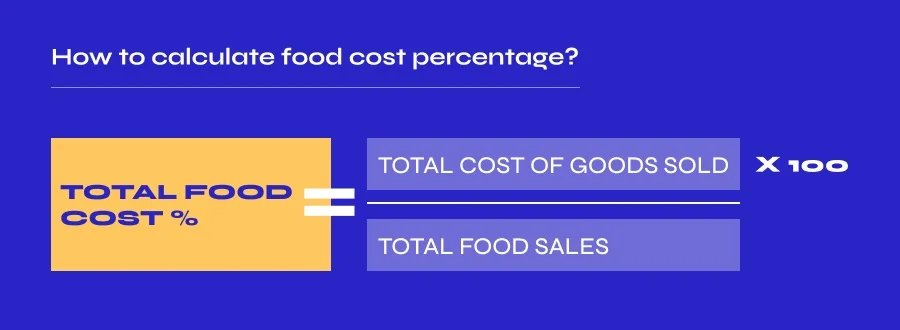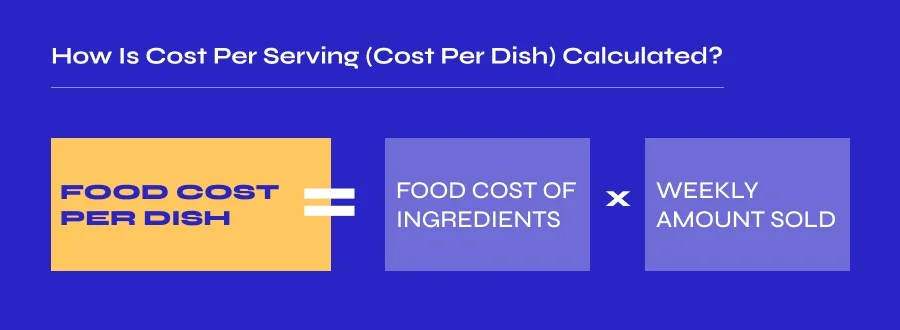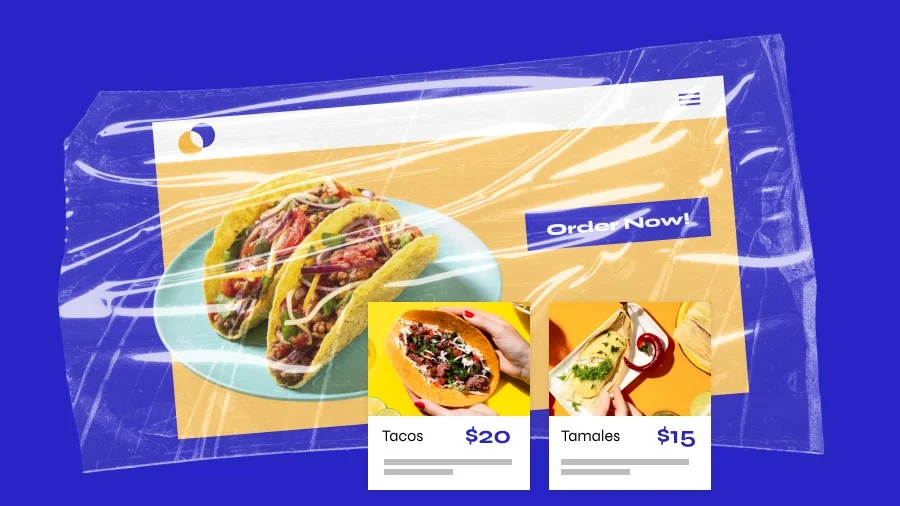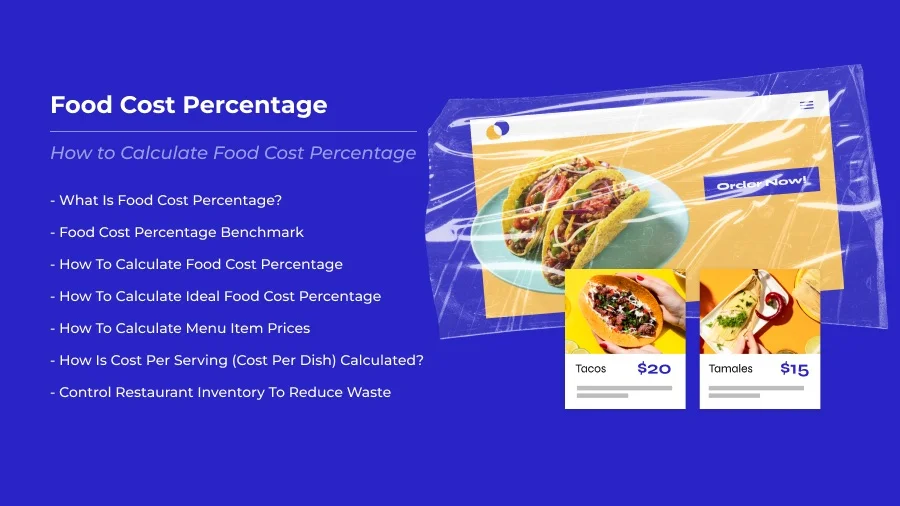Food Cost Percentage: How to Calculate Food Cost Percentage
Increasing revenues while minimizing costs – particularly food costs – is the goal of successful restaurant operators.
Restaurants that are profitable make informed decisions based on the cost of their suppliers' products. As the restaurant supply chain varies, this can be difficult to achieve. In order to take control of costs and maximize restaurant profits, restaurant owners, operators, and managers must track food cost percentages consistently.
Here are the numbers behind the food cost percentage formula. Find out how to calculate the food cost percentage manually. And get to know the benefits of restaurant food cost percentages.
What Is Food Cost Percentage?
Food cost percentage (FCP) calculates how much it costs your business to produce menu items relative to how much you charge for them. This key performance indicator can help you set menu prices and ensure you make a profit on every item on your menu. By comparing your restaurant’s food cost percentages to benchmarks, you can decide if you need to charge more for menu items and/or cut inventory costs.
Food Cost Percentage Benchmark
So, what food cost percentage should you strive for? If you don't have historical data from your own restaurant, looking at industry benchmarks can be useful.
In general, restaurants should limit their food expense proportion between 25 and 40%. That means that for every dollar of revenue, a restaurant will have spent between 25 and 40 cents on the ingredients that make up that dish.
Higher-end restaurants typically have higher food cost percentages, usually in the 38–40% range. Restaurants with minimal menus (like pizza parlors) can have food costs as low as 20%.
How to Calculate Food Cost Percentage
Your restaurant food cost is also known as your Cost of Goods Sold (CoGS), the total cost of all the ingredients you utilize to make the menu items sold over a certain period. Your food cost percentage is calculated as a percentage of sales.
The food cost percentage shows the relationship between the cost of making a dish and the profit made from that dish. You can compute your food cost percentage at each location by comparing your overall inventory COGS to your sales or on an individual dish level.
Food costing is a powerfully simple tool that requires an integrated, industry-specific Restaurant Enterprise Management software to constantly deliver accurate data. Consistent, accurate recipe costing is key—recipe costing breaks down menu items with the exact cost for portion sizes and specific ingredients. Your food cost percentage is derived based on the exact food cost of a dish using up-to-date vendor pricing and standardized recipes from your kitchen.
For accurate data, use inventory management software built for restaurants that simply integrates with your accounting and Point of Sale (POS) system to map inventory against sales. If you don't have automated tools for inventory control and recipe costing, use this formula to compute your food cost percentage at the store level:

How to Calculate Ideal Food Cost Percentage
You don't want to calculate your food cost without knowing where it should be (or vice versa). You want to know where your food cost percentage should ideally be based on your ingredient costs and standardized recipes, as well as what number your kitchens are hitting on a regular basis.
Comparing actual vs. theoretical (AvT) food costs is a powerful tool for food cost percentages. Understanding the gap between your actual inventory and recipe costs and what you planned for rapidly reveals the source of unexpected costs and creates your chances for improvement. To get your ideal food cost percentage, multiply your theoretical food cost by the cost of making all menu items over a certain time frame, assuming perfect portion sizes, no waste, no mistakes, and no theft. Your ideal food cost percentage is your theoretical food cost as a percentage of sales. Then, you can compare your theoretical food cost to your actual food cost, which is the food cost based on your current sales and inventory levels. The difference between these figures could be due to food waste, breakage, or theft.
Any variation indicates a breach in your profit margin, that should be investigated using your restaurant operations reporting software. While you won't always hit your target food cost, knowing where to seek efficiency is the first step towards decreasing the gap.
How to Calculate Menu Item Prices
Your restaurant most likely already has a profit margin target. However, it's easy to overlook the fact that your target profit margin is only possible if your target food cost is met.
When you understand your food costs, you can make smarter menu decisions. A good rule of thumb in the restaurant industry is to keep food cost percentages between 28 and 32%. The average food cost percentage varies between quick service and fine dining concepts, as well as between cities. It may even change within the same restaurant, depending on the menu for the day.
Your food cost percentage may not be the same for every dish. Overall, you want to be able to hit your target food cost percentage. Whatever food cost percentage your restaurant has, keeping this number in mind while pricing out your menu can help you ensure that each menu item adds to your profit margin.
Understanding your food costs will also aid you in meal planning. By knowing your food cost percentage, you can see which menu items are not as profitable, and raise prices, adjust ingredients to meet a new food cost percentage, or remove the items altogether.
How Is Cost Per Serving (Cost Per Dish) Calculated?
Calculating the food cost per dish gives insight into the costs associated with each menu item, allowing you to optimize your menu while effectively managing your budget. Simply use the following equation:

Control Restaurant Inventory to Reduce Waste
When it comes to food costs, one of the most effective ways to rapidly streamline the numbers is to set standards and procedures for your restaurant inventory management. Remember that your food cost percentage takes into account all of the inventory you use to make menu items. Thus, you will have a higher food cost percentage if you have high levels of waste.
Optimize your food costs by reducing waste throughout your operation.
Why is the Food Cost Percentage so Important?
Restaurant food costs are a significant component of overall operating costs, with labor costs being the other.
Your prime costs, or variable costs, are the sum of your food and labor costs. This is in contrast to fixed costs such as rent or mortgages, insurance, and other such costs.
Restaurant food cost percentages help operators track overall costs and specific ingredient prices. Monitoring restaurant ingredient cost variations can enable operators to make data-driven decisions for optimized spending, which aids in profitability.
Certainly, here's an example based on the scenario:
Let's say Mary runs a profitable restaurant that serves 250 customers every day. Mary can lose a significant amount of revenue over the course of a year if she does not pay attention to her food costs and her menu items are incorrectly priced by $0.95.
To calculate the potential annual revenue loss, use the following formula:
(250 consumers x 365 days per year) x $0.95
(91,250 consumers each year) x $0.95 = $86,687.50
So, if Mary's menu items are priced erroneously by $0.95, she could lose $86,687.50 in revenue per year.
Even seemingly insignificant costs can quickly add up – and that's only if your costs are nearly locked in. The savings from cutting food costs could be a major boost to your bottom line if you have a lot of room to spare.
Calculating food cost percentages and costs for goods sold at granular levels can reveal key trends and insights.
And, by calculating plate costs, you can combine recipe portions to find the precise impact of each menu item.
Benefits to Calculating Restaurant Food Cost Percentages
Here are three benefits to calculating restaurant food cost percentages.
1. Spend and earn wisely
By pricing each menu item based on food cost percentage and COGS, you can ensure that each menu item fits within your food cost margins. You'll then know which menu items are the most profitable and, as a result, which items to promote.
2. Effectively plan your menu
You can change menu items that are no longer profitable with food cost percentage data connected to your restaurant POS system. Menu engineering based on food cost percentages can provide you with the insight you need to develop a profitable menu pricing strategy.
3. Gain a better understanding of how the food supply chain affects restaurant expenses and profitability
The restaurant supply chain can be turbulent. Understanding and managing inventory costs can be aided by keeping an eye on farming trends and even international trade negotiations. Avocado prices, for example, rose 58% in July 2023. Having a food cost calculator to detect such swings can be critical in mitigating supply chain instability.
FAQs About Food Cost Percentage
1. What Is a Good Food Cost Percentage?
Most restaurant owners and operators keep food costs between 25 and 40% of revenue to run a profitable business. However, this standard is more of a guideline than a universal law for every restaurant. The average meal cost % differs across fast food restaurants and fine dining concepts, as well as between cities.
2. What Is a Restaurant's Average Food Cost Percentage?
Restaurant owners often select an optimal food cost percentage based on a number of factors, including their other labor and rent expenses. Many restaurants strive to limit food costs between 25 and 40% of revenue. This figure varies greatly depending on the needs of the business.

